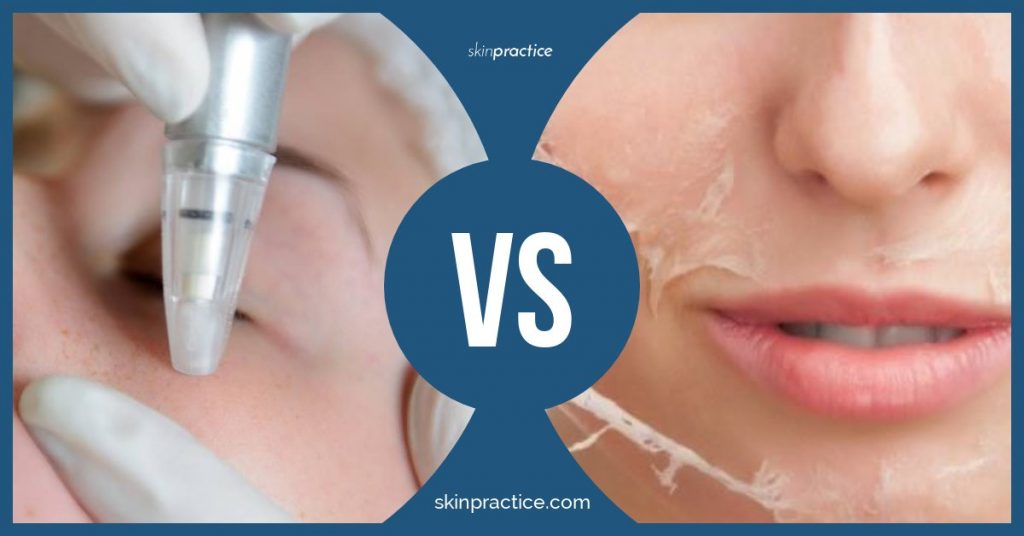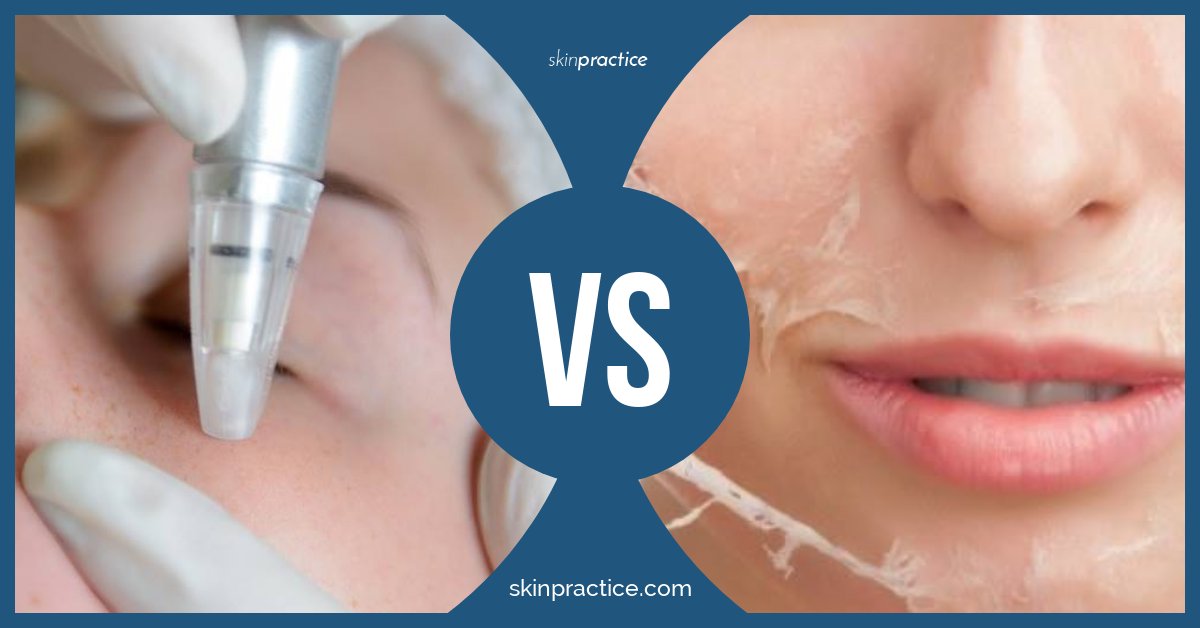More and more people, both men and women, are seeking the ultimate time-reversing method that will reduce the appearance of fine lines, wrinkles, dark spots or scarring. And most of them would rather prefer less invasive procedures.

Microdermabrasion and Chemical Peel are two of the most commonly performed anti-aging practices, providing younger-looking, radiant skin. Both procedures aim to even out the skin texture by removing the dead cells and contaminants of the skin surface, letting it regenerate faster.
Purpose
Both procedures target the complete removal of skin imperfections by exfoliating the superficial skin layer without damaging the skin underneath.
What is microdermabrasion?
Microdermabrasion is a technique for skin resurfacing, using a crystal or a diamond tip wand, often in a combination with a vacuum suction feature.
The conception is the removal of the dead skin cells, contaminants, and makeup residue on the skin’s outermost layer. This way, the pores open, the existing and potential irritants are eliminated and newly formed skin cells replace the ones that are removed during the procedure.
What is a chemical peel?
Chemical Peel is a procedure in which various weak organic acids are applied to the surface of the skin, providing a significant impact on its structure and appearance.
The target is to improve the skin tone by removing the damaged top layer and the turgor (the period your skin returns to its normal position after being pinched) by stimulating the formation of new collagen in the deep skin layers.
This makes your skin significantly fresher, dense, rejuvenated, evenly toned and the number of imperfections is reduced.
Light to mild chemical peels
Light to mild chemical peels treat the outer layers of skin. They allow the skin to rgeenerate quickly, and produce minimal textural changes. Some of the lighter chemical peels are:
- Glycolic acid peel
- Alpha beta acid peel
- Salicylic acid peel
Strong chemical peels
Strong chemical peels penetrate deep into your skin’s surface, impacting the deeper layers of skin. This allows the peel to address more severe imperfectins, such as acne scarring.
Microdermabrasion VS Chemical Peel
Microdermabrasion is considered the less invasive version of skin resurfacing. It uses a constant suction power, aiming to eliminate the upper skin layer (without causing damages).
During a microdermabrasion procedure, the user is likely to experience a slight tingling and warming sensation, which is followed by temporary irritation or redness.
The complete facial recovery usually takes no more than a few hours, users with extremely sensitive skin type may experience potential side effects (again, irritation or redness) during the next 2-3 days but the procedure is generally considered safe and mild.
Chemical Peel – depending on the type, chosen by the beautician, chemical peels have different strength. There are three options available – mild, medium and deep peel.
The least invasive is considerably more aggressive compared to microdermabrasion, as it requires (at least) a month of a recovery period. The deep chemical peel may need several (around 3) months of recovery.
The application of face bandages is another inconvenience that may be necessary following the procedure, not to mention the painkillers and antibiotics, often prescribed following such procedure.
So, chemical peels are more invasive, they appear to be a comparatively successful method for more severe skin issues (such as deep wrinkles or scars) but may provoke serious side effects afterward. Such include burning, swelling, and permanent skin discoloration.
Pros and Cons
Microdermabrasion Pros
- The procedure is suitable for all skin types
- It is the easiest way to obtain deep skin exfoliation
- Provides an instant rejuvenating effect
- Reduces pore size
- Evens out the texture of the skin and reduces the appearance of dark, pigment spots
- Reduces the appearance of mild to moderate acne (not recommended for severe forms of acne)
- Absolutely safe and relatively painless procedure
- Microdermabrasion can be safely performed at home
Chemical peel Pros
- Very beneficial for the reduction of fine lines and wrinkles
- Chemical Peel is considered a non-invasive, mildly aggressive procedure
- Proven effective for fixing blemishes and skin pigmentation
Microdermabrasion Cons
- Ineffective for deep wrinkles and scars
- You will need to spend some time doing in-depth research in order to choose the best microdermabrasion for you (crystal or diamond, at home or at a beauty salon)
- Individual results vary, which means that for some two sessions are enough, for others – 4 or more sessions may be required
- The procedures should be performed regularly, as the effect is not permanent
Chemical peel Cons
- This is one of the higher-priced techniques for deep skin exfoliation
- Side effects, including swelling, redness, and irritation are often available
- Requires a recovery period, which may vary from 2 weeks to 4 months
- Exposure to sunlight should be avoided during the entire recovery period
Effect
Both microdermabrasion and chemical peel are extremely effective techniques when it comes to removing the dead skin cells and dirt, accumulated on the skin surface, reduce fine lines and wrinkles, pore size and dark spots on the skin of the face and hands as well as the depth of scars, following acne or chicken pox. The blood circulation improves and the skin is instantly rejuvenated.
Post-procedure care
After a microdermabrasion procedure, the skin looks and feels softer, although its sensitivity may increase. Regular moisturizing is highly recommended in order to additionally promote regeneration. The application of sunscreen (SPF30+) is a must, as the skin becomes more fragile and ultraviolet radiation may cause damage to the cells.
When it comes to the chemical peels, the aftercare should be very precise as the skin becomes significantly more sensitive and requires specific care until it is fully restored. This period depends on the depth of the peeling.
After a mild peeling, the skin is usually reddish for a period between several hours to one day after the procedure. Then the redness gradually fades and slight flaking occurs on the surface layer of dead cells formed as a result of the procedure.
When it comes to a moderate or a deep peel, immediately after the procedure, the skin is reddish and irritated. It gradually thickens, forming a thick red-brownish crust within 36 hours, which gradually cracks and peels out of the surface of the skin in the form of large flakes.
Regardless of the depth of the peeling, it is important to apply a sunscreen with a maximum factor throughout the recovery period. For faster recovery, you can apply epithelial and antiseptic creams to speed up the regeneration process.
Price Comparison
A microdermabrasion session, performed in a professional office or at a beauty studio ranges from $75 to more than $200 per session. Consumers usually need five to twelve sessions spaced 15 days apart. 4 to 6 sessions are usually enough to reap full microdermabrasion benefits.
Another option is the purchase of a microdermabrasion system for at-home exfoliation. Such devices are usually less aggressive and can be used more often (the effect is similar to the professionally performed sessions).
The pricing varies between $60 and $250 and you can use the machine for an unlimited period of time.
Chemical peels can be performed by certified beauticians and certified skin practitioners only, as the procedure may provoke severe skin reactions. Your condition should be strictly monitored during the entire recovery process.
Conclusion: which is better – Microdermabrasion or Chemical peel?
Having reviewed all the positive aspects and the disadvantages of the two most popular skin resurfacing techniques, we would recommend you try the less invasive and painless procedure, Microdermabrasion.
This way, you can avoid the potential risks, following Chemical Peels, as those such include irreversible pigmentation (sometimes, following Phenol peel or other substances) in case your skin cannot completely recover after the procedure.



